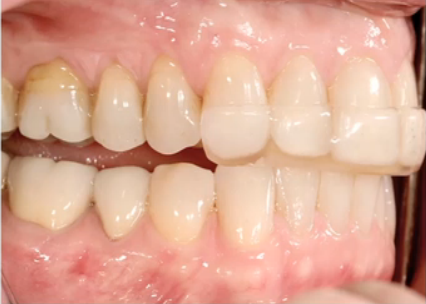Tooth Wear Appliances: Anterior Bite Planes
Selecting an occlusal appliance is an extremely confusing concept in dentistry. A common reason for this confusion is that dentists don’t always think about what they are actually using the appliance for.
Choosing an appliance for patients with tooth wear from attrition is done primarily to protect teeth and dental work from excessive frictional forces; however, if the patient has TMJ issues or muscle pain in addition to the wear, the appliance choice will need to consider those conditions as well.
An anterior bite plane is an appliance that has no posterior occlusion. The concept of this appliance is to separate the posterior teeth to help decrease muscle activity during clenching and grinding. Since there is no posterior occlusion, the lateral pterygoid is able to release and allows the condyle to seat.
Although there are different kinds of anterior bite planes, all the appliances are conceptually the same relative to the lack of posterior occlusion:
- Hawley bite plane. One of the older types of anterior bite planes. This particular appliance consists of a wire that extends around the labial bow and fits into the patient’s palate. The plane that rests against the lingual of the maxillary of the anterior teeth prevents any posterior occlusion.
- Sved appliance. A similar concept to the Hawley bite plane, the Sved appliance wraps acrylic around the patient’s incisal edges to protect the teeth and eliminates the labial bow.
- NTI. A more modern and narrower version of an anterior bite plane, this appliance covers the maxillary or mandibular anterior teeth, but usually has a narrow occlusal contact table allowing contact on only the two centrals.
Several variations of the above appliances have been fabricated and named by multiple labs and clinicians, but any appliance that has only anterior contact and no posterior occlusion fits this category.
An anterior bite plane is an excellent choice for patients with tooth wear from attrition because it reduces elevator muscle activity in clenching and grinding in most patients. In addition, its small size makes it very easy to wear. With extreme clenchers or grinders, it’s important to make a bite plane that has occlusion on at least four of the patient’s incisors, rather than just the two centrals, to prevent overload of the contacting teeth, which could result in tooth mobility, sensitivity, or fracture.
Although an anterior bite plane is a popular choice in patients with wear, there are some contraindications and risks. If your patient experiences joint pain on loading, or if their symptoms seem to worsen after wearing the bite plane, the bite plane should be taken out.
Patients who wear the appliance for more than the recommended 8–10 hours per day may experience eruption of posterior teeth or intrusions of anterior teeth. Another risk: Patients who have a major shift in their occlusion between their seated condylar position and their habitual occlusion can experience mandibular repositioning, resulting in the inability to find their old habitual position. But for the vast majority of patients, an anterior bite plane is an excellent appliance to protect teeth from wear and treat muscle symptoms.
FOUNDATIONS MEMBERSHIP
New Dentist?
This Program Is Just for You!
Spear’s Foundations membership is specifically for dentists in their first 0–5 years of practice. For less than you charge for one crown, get a full year of training that applies to your daily work, including guidance from trusted faculty and support from a community of peers — all for only $599 a year.

By: Frank Spear
Date: February 1, 2016
Featured Digest articles
Insights and advice from Spear Faculty and industry experts



